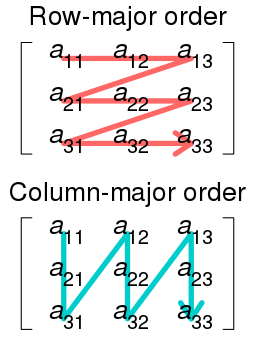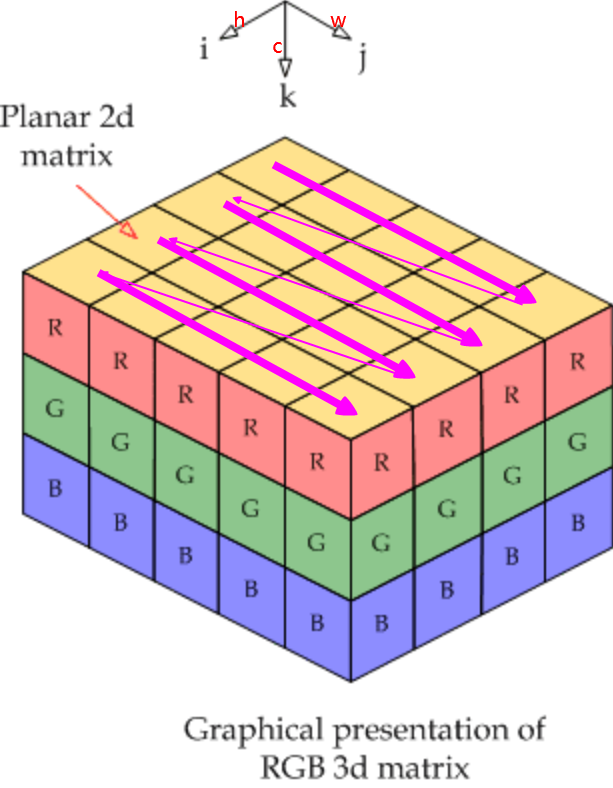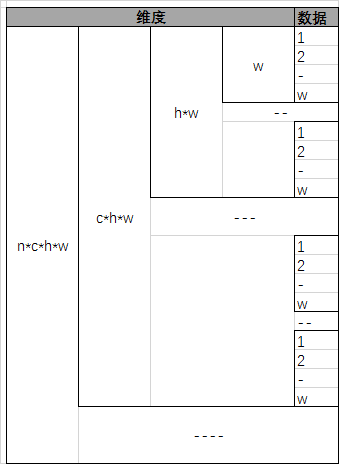Caffe源碼理解1:Blob存儲結構與設計
博客:blog.shinelee.me | 博客園 | CSDN
Blob作用
據Caffe官方描述:
A Blob is a wrapper over the actual data being processed and passed along by Caffe, and also under the hood provides synchronization capability between the CPU and the GPU. Mathematically, a blob is an N-dimensional array stored in a C-contiguous fashion.
Caffe stores and communicates data using blobs. Blobs provide a unified memory interface holding data; e.g., batches of images, model parameters, and derivatives for optimization.
Blobs conceal the computational and mental overhead of mixed CPU/GPU operation by synchronizing from the CPU host to the GPU device as needed. Memory on the host and device is allocated on demand (lazily) for efficient memory usage.
Blob是Caffe中的基礎數據結構,主要作用如下:
- 存儲和傳輸數據,對外提供統一的內存接口。在Caffe中,輸入圖像、每層的權重和反向傳播時的梯度、每層的輸入和輸出等都以
Blob形式管理 - 隱藏CPU和GPU之間數據同步的細節(通過
SyncedMemory實現),用戶使用時不需要自己管理CPU和GPU間的數據同步
在邏輯上,Blob是個\(N_d\)維張量。當\(N_d=4\)時,Blob的shape定義為\(N * C * H * W\),即\(Num * Channel * Height * Width\),可以表示輸入圖像Batch、卷積層的kernel參數、卷積層的輸入輸出map等;當\(N_d=2\)
具體地,
- \(N_d=4\),
Blob表示輸入圖像時,\(N\)為當前批次的圖片數量即MiniBatchNum,\(C\)為圖像的通道數,RGB圖\(C=3\),\(H\)和\(W\)為圖像的高和寬。 - \(N_d=4\),
Blob表示卷積層的輸入輸出時,\(N=1\),\(C\)為特征圖的數量,\(H\)和\(W\)為特征圖的高和寬。 - \(N_d=4\),
Blob表示卷積層kernel參數時,\(N\)為當前層輸出特征圖的數量,其與卷積核數量相同,\(C\)為當前層輸入特征圖的數量,其與一個卷積核的層數相同,\(H\)和\(W\)為卷積核的高和寬,每個卷積是三維的即\(C*H*W\)。 - \(N_d=2\),
Blob表示全連接層的權重時,shape為\(N_{out} * N_{in}\)的二維矩陣,\(N_{out}\)為輸出數量,\(N_{in}\)為輸入數量。 - \(N_d=1\),
Blob為長度為\(N\)的向量,表示卷積層bias參數時,\(N\)為卷積核數量(與輸出特征圖數量相同),表示全連接層bias參數時,\(N\)為輸出數量(與上面的\(N_{out}\)相同)。
主要成員變量
shared_ptr<SyncedMemory> data_; // 數據,存儲圖像、參數、輸入輸出等
shared_ptr<SyncedMemory> diff_; // 反向傳播時的梯度,訓練階段update時參數的更新量
shared_ptr<SyncedMemory> shape_data_; // GPU shape,與下面的shape是相同的
vector<int> shape_; // shape,data和diff相同
int count_; // 張量中的元素數量,比如 N*C*H*W
int capacity_; // 容量,當前分配內存的大小,當reshape時,可能需要擴容Blob存儲結構
Blob的data_和diff_對應的數據區,在內存中均以行有先的方式存儲(C語言風格)。行優先和列優先的存儲方式如下圖所示,9個數連續存儲,表示同一個矩陣,但是存儲順序不同,圖片來自WIKI:

當輸入圖像為1張RGB圖時,shape為\(1*3*4*5\),其存儲順序如下圖所示,圖片素材來自鏈接。channel維上,0為R,1為G、2為B,先在R上行有先存儲,再在G上行有先存儲,最後在B上行有先存儲。這裏僅作示意,在caffe中實際存儲順序為BGR。

當\(N=4\)時,\(Num * Channel * Height * Width\),Blob在\(Width\)維上連續存儲,如下圖所示:

理解了上圖,再理解多維Blob的拼接、裁剪等操作就很容易了。
通過Blob的offset成員函數可以獲得\((n, c, h, w)\)處的偏移量,偏移的計算方式與行優先存儲是一致的,代碼如下:
inline int offset(const int n, const int c = 0, const int h = 0,
const int w = 0) const {
CHECK_GE(n, 0);
CHECK_LE(n, num());
CHECK_GE(channels(), 0);
CHECK_LE(c, channels());
CHECK_GE(height(), 0);
CHECK_LE(h, height());
CHECK_GE(width(), 0);
CHECK_LE(w, width());
return ((n * channels() + c) * height() + h) * width() + w;
}CPU與GPU間的數據傳遞
const Dtype* cpu_data() const; // 不可修改數據,return (const Dtype*)data_->cpu_data();
const Dtype* gpu_data() const; // return (const Dtype*)data_->gpu_data();
Dtype* mutable_cpu_data(); // 可修改數據,return static_cast<Dtype*>(data_->mutable_cpu_data());
Dtype* mutable_gpu_data(); // static_cast<Dtype*>(data_->mutable_gpu_data());Caffe中通過上述方式來獲取CPU和GPU上的數據區指針,在調用函數時,SyncedMemory會自行判斷是否需要同步數據(具體是如何判斷的,在講SyncedMemory時再詳細說明),當訪問CPU(GPU)側數據時,如果GPU(CPU)側數據(可能)更新過,則將數據同步至CPU(GPU)。可參考下面示例代碼來理解何時會發生數據同步,示例代碼來自Caffe官網。
// Assuming that data are on the CPU initially, and we have a blob.
const Dtype* foo;
Dtype* bar;
foo = blob.gpu_data(); // data copied cpu->gpu.
foo = blob.cpu_data(); // no data copied since both have up-to-date contents.
bar = blob.mutable_gpu_data(); // no data copied.
// ... some operations ...
bar = blob.mutable_gpu_data(); // no data copied when we are still on GPU.
foo = blob.cpu_data(); // data copied gpu->cpu, since the gpu side has modified the data
foo = blob.gpu_data(); // no data copied since both have up-to-date contents
bar = blob.mutable_cpu_data(); // still no data copied.
bar = blob.mutable_gpu_data(); // data copied cpu->gpu.
bar = blob.mutable_cpu_data(); // data copied gpu->cpu.只要調用了mutable函數,即便沒有實際修改數據,再調用另一側的mutable函數,也會發生數據同步。因此,在明確不修改數據時,盡量調用const函數,只有在操縱數據時才調用mutable函數。
主要成員函數
Blob的主要成員函數有:
- 基本函數,包括構造函數、set和get類函數、邏輯判斷等
Reshape函數,用於設置Blob的shape,分配內存Update函數,用於在網絡訓練時更新參數使用,\(data = data - diff\)Blob運算函數,用於切片統計、求L1範數、L2範數、數乘等- 輔助函數,proto導入導出等
下面重點介紹其中主要的成員函數。
template <typename Dtype>
class Blob {
public:
Blob()
: data_(), diff_(), count_(0), capacity_(0) {}
/// @brief Deprecated; use <code>Blob(const vector<int>& shape)</code>.
explicit Blob(const int num, const int channels, const int height,
const int width);
explicit Blob(const vector<int>& shape);
// ......
}在Blob的構造函數中,會調用Reshape函數,給shape成員變量賦值以及分配初始內存。在Layer::Reshape或者Layer::Forward時,也會調用Reshape函數來設置輸出Blob的維度,如果reshape了整個網絡的輸入Blob,則需要調用Net::Forward或者Net::Reshape來重新確定每一層相關Blob的shape(從bottom到top逐層推算得出)。當Blob size發生改變時,只有在內存不夠才會再分配內存,具體代碼如下
template <typename Dtype>
bool Blob<Dtype>::Reshape(const vector<int>& shape) {
CHECK_LE(shape.size(), kMaxBlobAxes);
count_ = 1;
shape_.resize(shape.size());
if (!shape_data_ || shape_data_->size() < shape.size() * sizeof(int)) {
shape_data_.reset(new SyncedMemory(shape.size() * sizeof(int)));
}
int* shape_data = static_cast<int*>(shape_data_->mutable_cpu_data());
for (int i = 0; i < shape.size(); ++i) {
CHECK_GE(shape[i], 0);
if (count_ != 0) {
CHECK_LE(shape[i], INT_MAX / count_) << "blob size exceeds INT_MAX";
}
count_ *= shape[i];
shape_[i] = shape[i];
shape_data[i] = shape[i];
}
// 不夠時分配內存,原內存會釋放(shared_ptr)
if (count_ > capacity_) {
capacity_ = count_;
data_.reset(new SyncedMemory(capacity_ * sizeof(Dtype)));
diff_.reset(new SyncedMemory(capacity_ * sizeof(Dtype)));
return true;
}
else {
return false;
}
}在網絡訓練階段,根據損失函數以及反向傳播得到的梯度,獲得每層參數的更新量diff_,會調用Update函數來更新參數,如下
template <typename Dtype>
void Blob<Dtype>::Update() {
// We will perform update based on where the data is located.
switch (data_->head()) {
case SyncedMemory::HEAD_AT_CPU:
// perform computation on CPU
// data = data - diff, axpy: y = ax + y
caffe_axpy<Dtype>(count_, Dtype(-1),
static_cast<const Dtype*>(diff_->cpu_data()),
static_cast<Dtype*>(data_->mutable_cpu_data()));
break;
case SyncedMemory::HEAD_AT_GPU:
case SyncedMemory::SYNCED:
#ifndef CPU_ONLY
// perform computation on GPU
caffe_gpu_axpy<Dtype>(count_, Dtype(-1),
static_cast<const Dtype*>(diff_->gpu_data()),
static_cast<Dtype*>(data_->mutable_gpu_data()));
#else
NO_GPU;
#endif
break;
default:
LOG(FATAL) << "Syncedmem not initialized.";
}
}
值得一提的是,Blob維度索引支持負數,-1表示最後一個維度,與Python相同,實現代碼如下,在需要訪問某個維度時,先使用CanonicalAxisIndex獲得真正維度,比如CanonicalAxisIndex(-1)。
// axis_index the axis index.
// If 0 <= index < num_axes(), return index.
// If -num_axes <= index <= -1, return (num_axes() - (-index))
inline int CanonicalAxisIndex(int axis_index) const {
CHECK_GE(axis_index, -num_axes())
<< "axis " << axis_index << " out of range for " << num_axes()
<< "-D Blob with shape " << shape_string();
CHECK_LT(axis_index, num_axes())
<< "axis " << axis_index << " out of range for " << num_axes()
<< "-D Blob with shape " << shape_string();
if (axis_index < 0) {
return axis_index + num_axes();
}
return axis_index;
}其他函數,只取代表。
// set get
// 省略基本的set和get函數,如上面提到的const和mutable函數
// 返回(n, c, h, w)處的數據,return cpu_data()[offset(n, c, h, w)]
inline Dtype data_at(const int n, const int c, const int h, const int w) const;
inline Dtype diff_at(const int n, const int c, const int h, const int w) const;
void ShareData(const Blob& other); // 與另一Blob共享data,類似淺拷貝
void ShareDiff(const Blob& other); // 與另一Blob共享diff
// 從另一Blob拷貝,類似深拷貝
void Blob<Dtype>::CopyFrom(const Blob& source, bool copy_diff, bool reshape);
// 切片元素數量統計,count *= shape(i)
inline int count(int start_axis, int end_axis) const;
// proto序列化與反序列化
void FromProto(const BlobProto& proto, bool reshape = true); // 從proto導入
void ToProto(BlobProto* proto, bool write_diff = false) const; // 導出為proto
// 運算
Dtype asum_data() const; // data L1 norm
Dtype asum_diff() const; // diff L1 norm
Dtype sumsq_data() const; // data L2 norm
Dtype sumsq_diff() const; // diff L2 norm
void scale_data(Dtype scale_factor); // data 數乘,in place
void scale_diff(Dtype scale_factor); // diff 數乘,in place
// 邏輯判斷
bool ShapeEquals(const BlobProto& other); // 判斷shape是否相同以上。
參考
- Blobs, Layers, and Nets: anatomy of a Caffe model
- Row- and column-major order
- Caffe: a fast open framework for deep learning
Caffe源碼理解1:Blob存儲結構與設計
